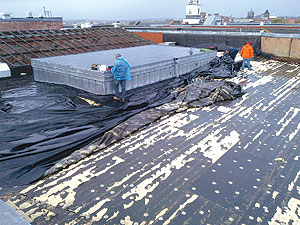
A recent engineering study found the high school building in need of extensive repairs. – Photo courtesy of the Maguire Group
Task Force to review options for aging high school
*
By Elizabeth Sheeran
Those who envision a new high school building in Somerville’s future could be one step closer to getting their wish. The mayor last week formed a task force to look at long-term possibilities for Somerville High School facilities, and all options are on the table.
An engineering study earlier this year found the current structure needed millions of dollars in repairs just to stay viable, and that was before Hurricane Sandy came along and caused extensive damage to the aging building, shutting down parts of the school indefinitely. The Somerville High School Building Task Force will weigh alternatives that range from costing out repairs to scouting out sites for a relocated campus.
In announcing the task force, Mayor Joseph Curtatone said respect for the building’s past has to be balanced against a responsibility to students’ futures. “As a graduate of Somerville High, I share the appreciation that many residents feel for this historically significant building, but I also want to make sure that all our facilities can provide the best possible educational experience for our city’s students,” said Mayor Curtatone.
The main high school building dates back to 1895, and Somerville High has had no significant upgrades or structural work since the gym and vocational wing were added in the 1980s. During the high school’s most recent round of re-accreditation by the New England Association of Schools and Colleges, the visiting committee recommended that Somerville begin to look at issues related to the condition of the school building.
Former Somerville High Headmaster Tony Cicciariello, who will chair the building task force, said it’s no secret that the age of the school building presents an added challenge for educators. “There were many times when we had to move classes because of a leaking roof or rain coming in around windows,” said Ciccariello. “The high school’s a beautiful building architecturally, it’s a phenomenal building. But at the same time, in my opinion, it’s a tired building.”
When the city last year contracted The Maguire Group to evaluate the building’s exterior, the engineering firm reported “extensive deterioration of masonry, windows and certain roofing areas.” Released in January, 2012, the Maguire report recommended $10 million in repairs to exterior walls, roofs and windows within the next four years, including $7 million needed within two years. “Delay in these repairs will only exacerbate the situation,” concluded the recommendation.

In the wake of Hurricane Sandy, temporary covering was put in place on the Somerville High School rooftop to prevent further damage to the auditorium below. – Photo courtesy of the City of Somerville
And as if city and school officials needed to be reminded of the building’s vulnerability, Superstorm Sandy blew into town on October 29 and ripped off the roof over the auditorium, exposing it to heavy rains. The city is still assessing the extensive damage to both the auditorium and the cafeteria kitchen below it, and is filing claims with insurers and with state and federal agencies. Meanwhile, the auditorium and kitchen remain off-limits until further notice.
School officials say staff and students have risen to the occasion to creatively work around the latest facilities problems, but all that maneuvering comes at a cost. For instance, this year’s musical The Wizard of Oz, which opens January 31, will have to move to the Somerville Theater. That means that one dollar from every ticket will be going just to pay for the theater rental, and there are other added expenses the school is just beginning to tally up.
Director Sarajane Mullins said students see a silver lining in the chance to perform at a professional theater. But she said it will be harder for students to get the same kind of learning experience off-site, where hired professionals will have to do a lot of the work. “When we’re in our own space, the best part of it is the kids can truly get exposure to everything,” said Mullins. “There’s no way the students will get to have the ownership that they’ve had in the past.”
Former Headmaster Ciccariello said the task force he’s chairing has to look beyond the short-term challenges created by immediate problems with the high school building and consider what kind of secondary school facility Somerville wants and needs to have longer term. And that question can’t be answered just by repairing old walls and roofing, because education has changed so much since the high school was built.
“The configuration is based upon a 19th century model. Do the classrooms we have meet the needs of young adults today? That’s a question the committee will be looking at,” said Ciccariello. He said attempts to retrofit space can only go so far. “Technology requirements being what they are today, the building doesn’t lend itself readily to upgrading, because of the limits that are inherent with a building that was constructed over 100 years ago,” he said.
Ciccariello said for now there are more questions than answers, and it will be up to the task force to listen to input, review the options, and consider whether the best long-term solution will be to re-invest in the current building, or start over from the ground up. He said he’s excited to begin work next month with the group, which brings together educators, public officials, construction experts and parents of future, current and past students of Somerville High.
Members include Tom Bent of Bent Electric, Howard Horton, president of the New England College of Business and Finance, School Committee Chairman Paul Bockelman, Alderman-at-Large Jack Connolly; City Capital Projects Manager Skip Bandini, City Engineer Rob King, Mayor’s aide Omar Boukili, and community members Judith Felix and Donna Haynes. The task force will aim to have initial findings for public review by the end of 2013, said Ciccariello.
When current Somerville High Headmaster John Oteri was announced as Ciccariello’s successor in April, he said he hoped to see serious groundwork for a new high school within five years. “That’s sort of a long term wish of mine,” Oteri said at the time, “I’d like to be there for the groundbreaking of a new high school and maybe the completion.”
Now, just months into his new role and having already faced more than his share of school building problems, Oteri’s enthusiasm for the prospect of a new high school building has anything but waned.
“I’m thrilled,” said Oteri, when asked about the building task force. “I think it’s the first step in securing that wish in getting a new high school for the city and for the students. It’s a long process and this is the first step.”















Reader Comments